Lake Ripples – August 2010
LCC's E-News Bulletin
Ban Pushed by LCC Will Result in<br> 2 – 3 Tons Less Phosphorus Loading!

Photo from morguefile.com
Effective July 1st, 2010 Vermont stores can no longer sell automatic dishwasher detergents that contain phosphorus. What does this mean for your dishes? Nothing! Phosphorus-free dishwashing detergents perform just as well as their phosphorus containing counterparts. This is great news for Vermont’s lakes and waterways! Phosphorus helps harmful algae thrive. It is easier and less expensive to reduce our use of phosphorus than it is to remove it at wastewater treatment plants. The ban is a result of a multi-year campaign LCC began in 2003 to get phosphates out of automatic dishwasher detergents. Similar legislation is pending in New York State.
Algae Update
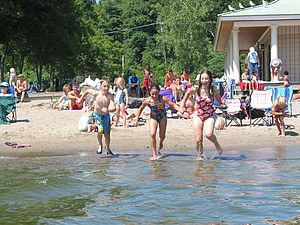
For much of the lake, swimming conditions have improved dramatically since early July when algae blooms were widespread. <br>Photo by Lori Fisher
Algae blooms on Lake Champlain have calmed down since early July when a heat wave triggered blooms from Charlotte to Port Henry. Sampling done by LCC monitors during the week of July 26th reported no blooms in the northern lake, Missisquoi Bay, the Main Lake, or the Inland Sea.
The one exception is in St. Albans Bay where blooms of potentially toxic algae species have been noted, but no actual toxins have been reported.
As always, algae blooms can pop up most anywhere in the lake, and will move around with shifting wind and water currents. Anyone recreating on the lake should watch for and avoid dense accumulations of algae. For help in identifying blooms, check out check out LCC’s pamphlet on floating phenomena (pdf).
Environmental Impact Statement Required<br> for Electric Cable Project Proposed for Lake Champlain
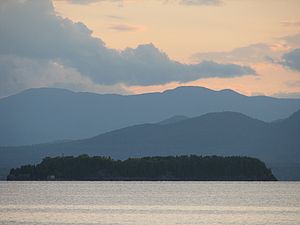
Photo by Carolyn L Bates
The Department of Energy has determined that an Environmental Impact Statement (EIS) will be required for the proposed underwater electric cable planned for the bottom of Lake Champlain. Champlain Hudson Power, Inc. applied for a permit to construct, operate, and maintain a high-voltage direct current transmission line that would carry electricity from sources in Canada to the New York City area. Part of the route for the cable would run along the bottom of Lake Champlain. The EIS will investigate potential environmental impacts and reasonable alternatives, including a ‘no action’ alternative. “The scale and scope of the project mandate a very thorough review,” noted LCC Executive Director Lori Fisher who attended meetings on the project in April and July. “LCC is concerned about any permanent alteration of the lake bottom and the potential impact on fish and other wildlife, wetlands, recreation and cultural resources.” As part of the alternatives analysis, LCC wants the EIS to consider routes such as utilizing existing railroad right of ways and address worst case scenarios should any equipment fail. “If the underwater line is ultimately approved, the permit should be conditioned so that Champlain Valley communities gain some ecological and economic benefit. One idea we’ve proposed is for the electric cable to supply power for an invasive species barrier in the Champlain Canal” said Fisher.
Tugboat McAllister
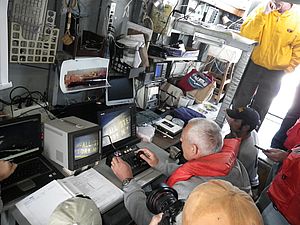
A crew from Phoenix Engineering pilots a remotely operated vehicle to inspect the Tugboat McAllister. From the Collection of the Lake Champlain Maritime Museum, photo by Adam Kane.
On June 15th, a team with representatives from the EPA, Lake Champlain Maritime Museum, the McAllister Company and Phoenix Engineering conducted an observation of the sunken tugboat William H. McAllister. The team used a remotely operated submersible vehicle to search for evidence of diesel fuel either having leaked from the tug or remaining in the fuel tanks and to identify potential means by which any remaining fuel might be removed, however the results where inconclusive.
The McAllister sank in 1963 after striking Schuyler Reef. It had been pushing a fuel oil barge and the crew of the McAllister was forced to scramble aboard the barge to escape. (For more information see LCC’s April Lake Look.)
Currently the EPA is working with the US Navy to set a time for a dive on the wreck. That dive is not expected to take place until at least the spring of 2011.
Climate Change in the Champlain Basin
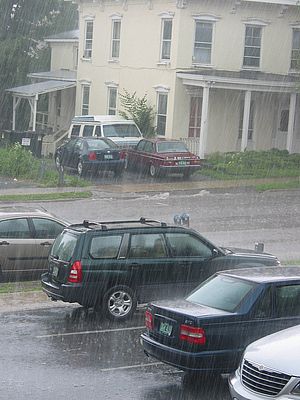
Climate change has triggered a greater frequency and intensity of storm events in the Champlain Basin. Photo by Mike Winslow
The Nature Conservancy (TNC) recently released a report titled “Climate Change in the Champlain Basin: What natural resource managers can expect and do,” one of the first efforts in North America to assess climate change on a watershed scale and offer adaptation strategies. LCC Staff Scientist Mike Winslow served as a reviewer on the report.
The 42-page document determines that climate change is no longer just a philosophical or future threat, it's a reality in the Champlain Basin. Some changes that have already taken place include:
- Mean temperatures in the Champlain Basin rose by 2°F between 1976 and 2005, slightly faster than the global average.
- The average level of Lake Champlain is 1 foot higher than it was prior to the 1970s.
- The duration of ice cover on local lakes has shortened during the 20th century, with freeze-up now occurring two weeks later, on average. The main body of Lake Champlain now often fails to freeze over at all in winter.
The most effective techniques for adapting to these and other related changes include vegetated shoreline buffers and best management practices to keep runoff and nutrients out of waterbodies. These are actions which LCC has been advocating over the years. We are currently working to identify ways municipalities can adapt to the anticipated warmer temperatures, and greater frequency and intensity of storm events resulting from climate change. While state and federal agencies have the capacity to develop adaptation plans, municipalities have fewer resources. Thus, LCC’s work will fill a gap in efforts to adapt to a changing climate.
To read the report online and access the Web-based Climate Wizard tool, go to www.nature.org/champlainclimatereport. To order copies of the report, email vermont@tnc.org.
The Mutual Suffering of Milfoil and Algae
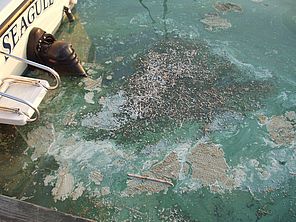
Eurasian water milfoil (milfoil) is the bane of many a lake user. This aggressive non-native plant invades lake systems and spreads prolifically, choking out other plants and making swimming, boating, and fishing more difficult. New populations arise from small fragments of plant that become established in a water body. Further fragmentation then expands the population. Between 2005 and milfoil’s first US appearance in 1942 the plant had spread to 45 of the 48 lower United States according to the USGS Non-indigenous aquatic species web page. When it comes to invasive aquatic plants, milfoil is the monster of them all. Yet, in some cases, milfoil can help prevent algae blooms, while high densities of algae can limit the growth of milfoil. MORE
LCC Links
- Upcoming Events
- Join/Donate
